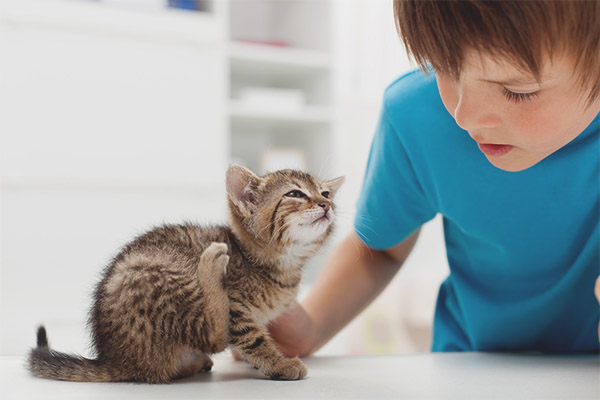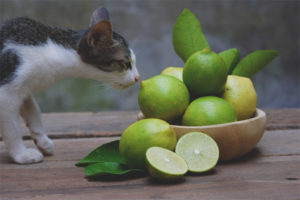The content of the article
An animal can get into the house in different ways - some kittens are brought from the street by children, someone is already born in your home, and sometimes you decide to have a pet and take it from a friend. No matter how the baby gets into your family, it should be prepared for further residence. And the very first thing that needs to be done is to save the kitten from parasites. Fleas in a newborn kitten most often appear from the mother, with whom he is in close contact. However, do not worry about it in the first weeks of the life of the animal. The fact is that a cat, as a rule, licks a kitten and at the same time “bites out” insects. The absence of a long and fluffy fur at an early age kittens allows you to do this without difficulty. Already after weaning, after about 5-6 weeks from birth, you can save the baby from blood-sucking parasites.The difficulty of getting rid of fleas kittens is that we can not use aggressive chemicals, as for adult cats. In the fight against fleas in a kitten, you need to use sparing, but at the same time effective ways that we will tell you about.
How to understand that a kitten has a flea
Of course, if you saw a black jumping point on the animal's fur, there is no doubt that the baby is infected with parasites. But what signs can tell that a kitten has a flea? Indeed, not only cat, but also dog parasites can live on its wool. A kitten can pick up insects through mom-cat or other animals with which it communicates and plays. In addition, if the baby goes for a walk on the street, it is not difficult to bring fleas into the house from the attic or basement. It is not difficult to recognize a flea kitten - it constantly itches, it becomes restless, its body and skin are abrasions and wounds. If your pet has similar symptoms, you should immediately examine it. Have you found at least one parasite on the animal's fur? If the baby is still small and lives with the mother, you should not use any means, because the cat constantly licks the baby's fur, poisonous components can get into her body. In addition, as soon as you get rid of fleas, the baby picks up parasites from the mother again.Therefore, you should not get rid of parasites before you wean the baby off the cat. The first, the safest and most gentle way to get rid of blood-sucking is mechanical cleaning.
Combing a kitten from fleas
For a kitten is the best way to get rid of fleas, because in this case he is not subjected to any treatment. In addition, combing is much more acceptable than bathing, since contact with water for a baby is stressful. Before you start combing, you should prepare a small bowl with water, in which you need to add a little household chemicals - means for washing the gas stove, tiles, etc. It is better if the product is with bleach or bleach. A container with water is necessary in order to throw caught parasites into it. After all, fleas have a fairly hard abdomen, they do not crush fingertips. You can destroy the parasite, for this it should either heal between the nails, or press to another solid surface. But when in the hands of a small kitten who tries to escape and run away, it is very inconvenient to crush fleas.But if you throw an insect into a prepared cup of detergent, you will instantly destroy it.
Sit in a comfortable position, lay a light towel or a sheet on your knees so that you can see dark fleas on its background. Take the kitten in your arms, prepare a frequent comb, preferably a metal one. Carefully comb the animal's coat, centimeter by centimeter. As soon as you notice the parasite, immediately try to pull it out and throw it into the prepared water. Some owners are quite difficult to pull fleas out of wool, for this there are special tweezers with rounded edges, so as not to injure the pet's skin. Using such tweezers, it is much easier to pull out fleas. Carefully comb your kitten from tip of nose to tip of tail. Especially pay attention to the abdomen, groin area and underarms - there fleas live most often. Of course, the processing can take you more than one hour, but it's worth it, you can save your pet from fleas. Sometimes it is impossible to completely clean the animal's hair, but even partial removal of parasites has a positive effect on the state of health of the kitten.
After manual cleaning should carefully handle the place where the baby lives. This is done to avoid re-infection. It should be thoroughly vacuumed carpets and rugs, wash at a high temperature all textile items, after washing, they should be smoothed out. Rinse the floor thoroughly with insecticide solutions, paying particular attention to the crevices and corners. The bedding of the animal must be properly processed with steam. If there are other animals in the house, you should poison the fleas of all at the same time to prevent re-infection.
How to bathe a kitten to get rid of fleas
If there are enough fleas, combing them is simply unrealistic. In this case, the kitten can be bathed using special parasite shampoos for the procedure (for example, Mr.Kiss, Rolf Club, Phytoelite). Many of them not only relieve parasites, but also take care of hair, moisturize the skin. Remember that they should be just for kittens, aggressive chemicals for adult cats will not work! If you have not found such a shampoo, the usual tar soap will do. It is absolutely safe even for kittens, but is effective in the fight against fleas.
- To begin, prepare a towel, cotton, detergent, a small dipper or cup, a basin with warm water of about 38 degrees.
- In the ears of the animal, place small balls with cotton, they are necessary to protect the crumbs from moisture. Water in no case should not get a cat in the ear, it is dangerous.
- Take the baby in your arms and gently lower it into warm water so that only the pet's feet are immersed in it. Dampen the animal's coat and gently lather it from the tip of the tail to the neck. Do not touch your head!
- At the time of soaping, fleas may start to scatter or rise to the face - try to destroy them immediately.
- After soaping the baby should stand “in the foam” for another 3-5 minutes. But remember that you need to bathe the kitten in a warm room so that it does not freeze.
- Then you need to wash off the kitten foam and dirt, gently sprinkling it with clean water. Mordochka and head can not be watered, you can simply wipe with a damp cloth.
- At the end of the kitten promakivayut towel. If the baby is not afraid of the sound of a hair dryer, it should be thoroughly dried so that the kitten does not get sick.
In general, it is rather difficult to wash an animal alone, try to take someone as an assistant.Usually one person soaps, and the other keeps a pet. After water procedures, you should carefully scour the tortured baby - so you can remove the half-dead parasites that are under the influence of tar soap. On the day of the water treatment, try not to let the kitten out on the street, beware of drafts, because the baby can get sick. Colds are transferred by kittens rather difficult, so you need to be alert.
Special means for removing fleas
When there is no time for bathing and combing, you can use other proven tools. However, remember, most of them are intended for adult cats and kittens older than 5 months. Before using specialized tools, read the instructions!
- Drops. It is possible to use such means only from the age of four months, not earlier. Drops are a special viscous fluid that repels fleas. It is applied with a pipette to the withers. The hair on the neck should be pulled apart, a drop of the medicinal composition should be dropped on the skin and carefully rubbed all over the back.Some manufacturers recommend applying the tool along the spine along the entire length of the back. Among the medicinal drops from fleas can be distinguished Bars, Advantiks, Stronnghold, Beaphar, and others. One application lasts for several weeks. Some manufacturers produce a special series for kittens, while others limit the use of the agent only in concentration. That is, if an entire pipette of the medicinal composition is needed for an adult cat, for a kitten one drop will be enough.
- Collars. These collars are made of special rubber, impregnated with an insecticidal composition. For kittens, there are safer collars that are impregnated with a herbal extractor, that is, with an extract of plants that repel parasites. Many collars are made with a special clasp that allows you to adjust the size of the accessory as the animal grows. Plus the collar is that the smell follows the animal everywhere, it not only eliminates the existing fleas, but also protects against new infection. You can safely send the animal to the street, without fear that the baby will again bring with them "intruders".The lack of a collar - some cats can not get used to the new "decoration", constantly trying to remove it. Popular brands of collars - Hartz, Bolfo.
- Powder. Unlike drops, powder is safer and is permissible to use since one month. Applying it is not difficult, you need to gently rub a small amount of powder into the animal's fur. The parasites die in the first few hours after treatment, the dead fleas should be combed out.
- Sprays This tool is effective if you need to get rid of fleas here and now. Spray should be applied carefully, so as not to get the cat's eyes. After applying the product, you need to monitor for another 10-15 minutes so that the baby does not lick the wool, you can distract him with games. When the specified time passes, you should simply wipe the animal with a damp cloth or bathe.
- Home plant remedies. They do not act immediately, but the result lasts a long time. Everyone knows that fleas are wary of the smell of wormwood, tansy, garlic, geranium, calamus, lavender. You can apply the essential oils of these plants to the fur or lubricate the wool with a decoction of these herbs. If you fill the animal bedding with fresh sawdust, only memories will remain from fleas, parasites are very afraid of woody smell.Keep a bunch of wormwood or tansy close to the cat's habitat and you won't have fleas.
Such treatments can be carried out only if the kitten is weaned from the cat, otherwise the mother can lick the medicinal composition from the coat, it is very dangerous for her. If the kitten is still with the mother, the first couple of days after treatment should be moved out and fed with milk from the pipette.
Home prevention in the fight against fleas is hygiene. Keep your cat's habitat clean, maintain animal hygiene, use all kinds of protective equipment, and the parasites will not disturb you!
Video: how to get fleas in kittens












To send